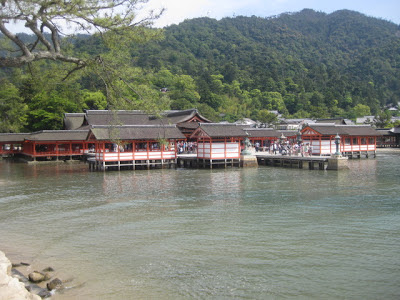Itsukushima is an island in the western part of the Inland Sea of Japan, located in the northwest of Hiroshima Bay. It is popularly known as Miyajima the Shrine Island, best known for its famous "floating" O-torii gate. The shrine complex is listed as a UNESCO World Heritage Site and the Japanese government has designated several buildings and possessions as National Treasures. The area designated for World Heritage comprises of the 431 hectares including the Itsukushima Shrine, and the adjacent sea, and the Mt Misen Primeval Forest (National Treasure) to the rear.
The O-torii Gate is about 16 meters in height and weighs about 60 tons. The main pillars are 9.9 meters in circumference, and made of natural camphor trees, while the four supporting pillars are made of natural cedar. The present O-torii was erected in 1875, and the eighth since the Heian Period (the last division of classical Japanese history, running from 794 to 1185).
According to records, the shrine was established in the time of Empress Suiko. The warrior-courtier Taira no Kiyomori gave the shrine its present form. In 1555, Mōri Motonari defeated Sue Harukata at the Battle of Miyajima. Toyotomi Hideyoshi built a large building, the Senjō-kaku, on a hill above the shrine.
The first shrine buildings were probably erected in the 6th century, and the shrine has been destroyed many times. The present shrine dates from the mid-16th century, and follows the earlier 12th century design. That design was established in 1168, when funds were provided by the warlord Taira no Kiyomori.
The island of Itsukushima, including the waters around it (part of Seto Inland Sea), are within Setonaikai National Park. This sea is affected by strong tides. At low tide, the bottom of the sea is exposed past the island's O-torii. At high tide, the sea covers all the previously exposed mud and fills areas underneath the shrine.

The Itsukushima Shrine at high tide, when it appears to float on the water. The shrine was designed and built on pier-like structures over the bay so that it would appear to be floating on the water, separate from the sacred island, which could be approached by the devout.
Mt. Misen is the highest peak on Miyajima island, 535 meters above sea level. Since the year 806 it has attracted devout worshipers. The natural environment has been kept intact which creates magnificent scenery.
 |
| Mt. Misen Ropeway (unfortunately it was a rainy day) |
 |
| Wait at the ropeway station platform between gondola changes |
 |
| Kiezu-no-Reikado Hall |







No comments:
Post a Comment